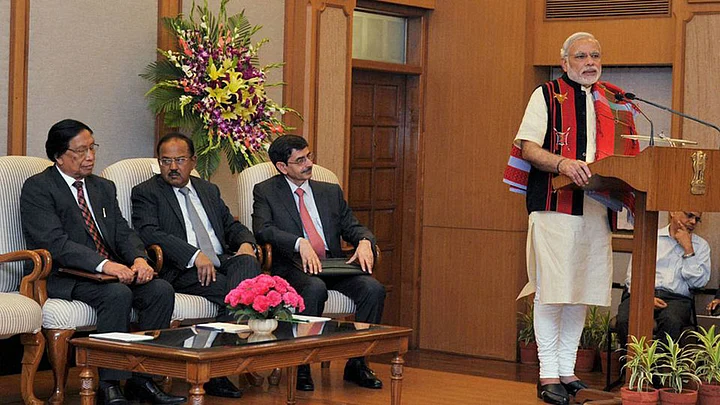Nagas and Historical Complexities
- Both the Congress/UPA, and the NDA governments spent equal amount of time in carrying out these negotiations in very trying circumstances
- The NSCN(IM) leadership is satisfied with the accord, as the government has acknowledged the unique history and situation of the Nagas
- Various accords, peace talks by Jaya Prakash Narain, an eight-year ceasefire, talks with Indira Gandhi and even formation of Nagaland state in 1963, did not quell the insurgency
- There are intense rivalries between the leaders and cadres of NSCN(K) and NSCN(I-M), resulting in continuous warfare between the two
Though the details of the Naga peace accord, also labeled as a “framework agreement” signed between the Centre and the NSCN(IM) have not yet been disclosed, the pact must be welcomed, since it is a step forward in the peace process commenced some 20 years ago by the then Prime Minister P V Narasimha Rao. It was subsequently formalised as a “ceasefire agreement’ between the two parties and carried forward by all successive prime ministers as an unconditional political dialogue to find a mutually acceptable and honourable solution to the Naga insurgency.
I have had the privilege of being the government’s interlocutor for these peace talks from July 1999 to September 2009. Both the Congress/UPA, and the NDA governments spent equal amount of time in carrying out these negotiations in very trying circumstances.
It would be premature to comment on the prospects of the accord, leading within a reasonable timeframe, to a permanent solution to the Naga issue. The NSCN(IM) leadership is satisfied with the accord, as the government has acknowledged the unique history and situation of the Nagas, and NSCN(IM) believes that it would lead to a satisfactory solution. However, at this point in time, it would be useful to understand the complexities of the Naga situation, which can guide in detailing a comprehensive accord and in implementing it on the ground.
The Naga insurgency is as old as our independence. The Naga Hills area was the last territory to come under British rule, as late as 1869. Naga is a generic word given by outsiders to a large number of tribes, with some common features, inhabiting the area of present Nagaland, across the border in Mynamar, and the hill areas in adjoining states of the northeast. Each tribe by and large live in a specific territory (usually a district) though in recent times there are areas where more than one tribe lives.
Birth of Naga Insurgency
When the freedom movement was at its peak in the country, there were stirrings of yearning for freedom in Naga areas also, but their leader Phizo tried to create a sense of Naga unity, and wanted a free Nagaland. As negotiations between the government of the time and the Naga leaders failed, the Naga National Council (NNC – the first political party of Nagas) declared independence on August 14, 1947, formed a “government”, with an armed wing, and insurgency was born.
Various accords, peace talks by Jaya Prakash Narain, an eight-year ceasefire, talks with Indira Gandhi and even formation of Nagaland state in 1963, did not quell the insurgency. Over the course of time, due to differences in strategy, a new and more powerful militant organisation, NSCN, was formed, which again split due to personal differences and strong tribal loyalties, into the Khaplang faction and Issac Swu-Muivah faction,.the latter being more powerful. Muiwah is a Thangkul (only found in Manipur hills) and Khaplang from Hemi tribe found in Myanmar, though Khaplang has a lot of influence amongst the Konyak tribe in Nagaland.
The NSCN(IM) cadres are basically drawn from the Thangkul and other Naga tribes of Manipur, and from the Sema tribe of Nagaland. Instead of abating, insurgency spread to Naga areas in Manipur and almost all other ethnic groups in the northeast started their own insurgent groups. To make matters worse, the factions led by Muivah and Khaplang formed umbrella organisations of various other northeast militant outfits, providing them safe haven, shelter, training, supply of arms and help in procuring weapons, providing safe passage etc, earning the Naga insurgency the sobriquet, ‘mother of insurgencies.’
NSCN(IM)’s Peace Overtures
In 1995, when the law and order situation in Nagaland was quite dismal, the NSCN(IM) made some peace overtures and expressed a desire to have a ceasefire with government forces and wished to seek a negotiated peaceful settlement. Muivah said that his faction by and large represented the views and aspirations of most of the Nagas and therefore the government should invite him for talks. The government’s intelligence sources supported this and thus the ceasefire agreement of 1997.
There are intense rivalries between the leaders and cadres of NSCN(K) and NSCN(I-M), resulting in continuous warfare between the two, by encroaching into each other’s area of influence. After the NSCN(IM) signed ceasefire agreement, the NSCN(K) through its political supporters wanted a similar agreement.
For about four years, the NSCN(IM) took the stand that if the government thought that Khaplang is the one who matters and can usher in peace, it may sign a ceasefire agreement with the NSCN(K), but the former would then withdraw from the ceasefire and talks. After much persuasion, Muivah relented and a ceasefire agreement was signed with NSCN(K) in April 2001, though as far as I know, no charter of demands was submitted by it till 2009.
(To be continued)
(The writer, a former Union Home Secretary, was the Centre’s interlocutor between 1999 and 2009)
